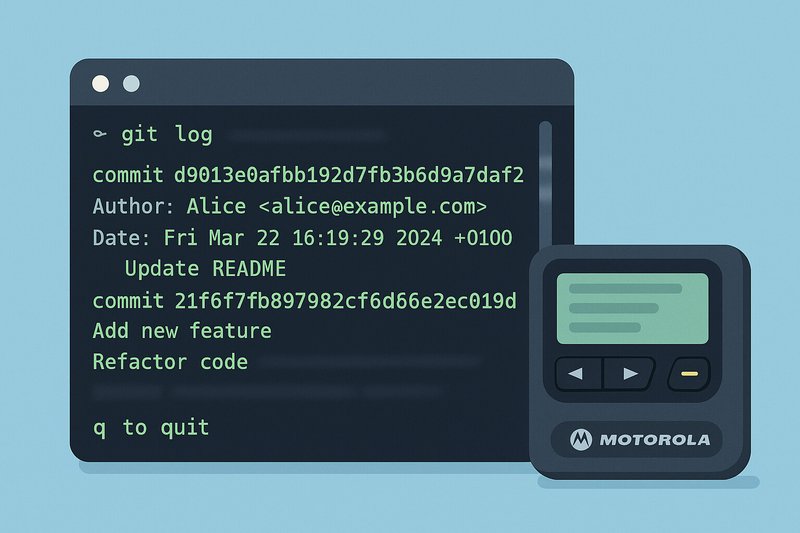That Weird Scrolling Thing in Git Has a Name (And You Can Configure It)
Discover what pagers are, why git uses them, and explore modern alternatives to the default less pager for better command-line productivity.

You know that moment when you run git log and suddenly you’re in this scrolling interface you didn’t expect? The one where you’re trapped until you figure out to press q? That’s a pager, and I’d bet you use one every day without knowing it.
I ran a very informal survey at TNG recently, and the results were telling: 17 people said yes, they use a pager. 32 didn’t know the term or weren’t sure if they were using one with git. 4 people mentioned they intentionally don’t use them. My favorite response? 5 people reacted to my joke about their “pager still being from Motorola.”
If you’re in that middle group of 32, this post is for you.
What’s Actually Happening
A pager is a program that displays text one screen at a time. When you run commands like git log, aws logs describe-log-groups, or even man less, and the output is longer than your terminal height, these commands automatically pipe their output to a pager instead of dumping everything at once.
That scrolling interface isn’t git being weird - it’s doing you a favor by making long output readable.
The most common pager you’ve probably encountered is less (yes, as in “less is more”). It’s been the default on most systems for years. But here’s the thing: less probably isn’t the best option anymore, and you have choices.
A Brief History of Screen Management
Back in the early days of Unix, terminals were physical devices with limited screen real estate - often just 24 lines of text. When you wanted to read a long file or manual page, the text would just scroll past faster than you could read it. The solution was more, created in the late 1970s as part of BSD Unix.
The name “more” came from its simple prompt at the bottom of each screen: --More--. You could press space to see the next screen, but that was about it. If you missed something, tough luck - more only went forward.
This limitation frustrated developers, particularly Mark Nudelman, who in 1985 created less with the philosophy “less is more” (the opposite of the architectural principle). Unlike more, less could scroll backwards, had better search capabilities, and could handle pipes without buffering everything into memory first. It quickly became the standard on most Unix systems.
Then came most in the 1990s with the tongue-in-cheek tagline “less is more than more, most is more than less.” Its key innovation was supporting multiple files simultaneously - you could view several files at once in different windows, plus it added horizontal scrolling for those annoyingly wide log files.
Taking Control
You can configure which pager gets used in three main ways:
System-wide default:
export PAGER=your-pager-choiceGit-specific:
git config --global core.pager your-pager-choiceAWS CLI:
aws configure set cli_pager your-pager-choiceWant to disable pagers entirely? Set any of these to cat and output will just dump to your terminal like the old days.
Your Pager Options
The landscape has evolved quite a bit beyond the traditional less. Here’s what’s out there:
Traditional Options:
more- The original pager, still works fine for basic needs (built into most systems)less- The longtime standard (but maybe not the best choice anymore) (built into most systems)most- Supports multiple windows and horizontal scrolling for wide files
Modern Alternatives:
ov- Feature-rich with visual enhancements like column-rainbow modeslit- Built specifically for handling noisy logs (great for developers)moor- Better UTF-8 handling for modern international textstreampager- Optimized for command output and large filesles- Improved features over the traditionalless
Personally, I’m currently trying moor - not because I’m convinced it’s the best, but because I wanted to see what modern pagers actually offer. Your mileage may vary.
The Bottom Line
If you’re one of those 32 people who didn’t know what a pager was, you now know you’ve been using one all along. And unlike that Motorola pager gathering dust in a drawer somewhere, this one you can actually configure to work the way you want.
Try a few options, see what clicks with your workflow. Or stick with less if it’s working for you. The important thing is knowing you have a choice.
Speaking of choices, I just published a small script that adaptively either invokes your actual pager or falls back to cat depending on your terminal emulator. This is particularly helpful when working with agentic IDEs like Cursor, which tend to struggle with interactive pagers. The script detects when you’re in a proper terminal (like iTerm) versus an embedded terminal and adjusts accordingly.
What pager are you using? Or are you team “dump everything to terminal”? I’m curious to hear what works for different people’s workflows.